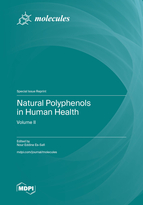Natural Polyphenols in Human Health
A special issue of Molecules (ISSN 1420-3049). This special issue belongs to the section "Chemical Biology".
Deadline for manuscript submissions: closed (31 March 2023) | Viewed by 129955
Special Issue Editor
Interests: medicinal plants; natural products; polyphenols; essential oils; extraction; isolation; characterization; biological properties; chromatography; spectroscopy; nuclear magnetic resonance; mass spectrometry
Special Issues, Collections and Topics in MDPI journals
Special Issue Information
Dear Colleagues,
Polyphenols are natural secondary metabolites recognized as one of the largest and most widespread classes of plant constituents occurring throughout the plant kingdom, representing one of the main phytochemicals found in plant-based foods and plant-derived foods and beverages. Nowadays, thousands of polyphenols have been isolated and characterized with a panoply of structures, ranging from simple phenolic molecules to polymerized compounds with higher molecular weights. Over the years, polyphenols have attracted the attention of the scientific community due to their potential health-promoting effects and the large and diverse panel of biological activities, many epidemiological studies having shown people who follow polyphenol-rich diets to be less prone to risk for a range of pernicious and chronic diseases, such as obesity, diabetes, cancer, heart disease, etc.
Owing to their several interesting properties, polyphenols have aroused considerable interest, shedding light on their chemistry, reactivity, biological properties and their beneficial effects on both plants and humans, and, as a result of these investigations, a huge number of research works have been reported on polyphenols. However, despite the voluminous literature studying polyphenols and their impact on human health, there are still many issues, discrepancies and controversies waiting to be investigated and explored in order to explain and elucidate the positive effects of polyphenols on human health. Questions regarding the chemistry of polyphenols, their biological activity, clinical studies, bioavailability and mechanism of action, in addition to the evidence of their real beneficial effects on human health, are still unclear and need answering. Thus, the field of polyphenols remains an open research area of high interest, given the importance of such bioactive natural compounds and their relation to human health.
This Special Issue of the Molecules journal aims to gather up-to-date knowledge related to the cutting-edge research in the broad scientific area of polyphenols, providing an opportunity to show the latest advances in the exploration of polyphenols and their health beneficial effects. Covered aspects include, but are not limited to, the chemistry, biological activity, in vivo and in vitro bioactivities, toxicity, bioavailability, bioaccessibility, metabolism, gastro-intestinal absorption, etc. We are confident that this Special Issue of Molecules could be of great interest to the broad research scientific community, and will contribute to the improvement and expansion of knowledge regarding the area of polyphenols, leading to a better understanding of their role in human health.
Prof. Dr. Nour Eddine Es-Safi
Guest Editor
Manuscript Submission Information
Manuscripts should be submitted online at www.mdpi.com by registering and logging in to this website. Once you are registered, click here to go to the submission form. Manuscripts can be submitted until the deadline. All submissions that pass pre-check are peer-reviewed. Accepted papers will be published continuously in the journal (as soon as accepted) and will be listed together on the special issue website. Research articles, review articles as well as short communications are invited. For planned papers, a title and short abstract (about 100 words) can be sent to the Editorial Office for announcement on this website.
Submitted manuscripts should not have been published previously, nor be under consideration for publication elsewhere (except conference proceedings papers). All manuscripts are thoroughly refereed through a single-blind peer-review process. A guide for authors and other relevant information for submission of manuscripts is available on the Instructions for Authors page. Molecules is an international peer-reviewed open access semimonthly journal published by MDPI.
Please visit the Instructions for Authors page before submitting a manuscript. The Article Processing Charge (APC) for publication in this open access journal is 2700 CHF (Swiss Francs). Submitted papers should be well formatted and use good English. Authors may use MDPI's English editing service prior to publication or during author revisions.
Keywords
- polyphenols
- characterization
- biological properties
- beneficial effects
- bioavailability
- human health
- antioxidant
- chronic disease
- functional foods







